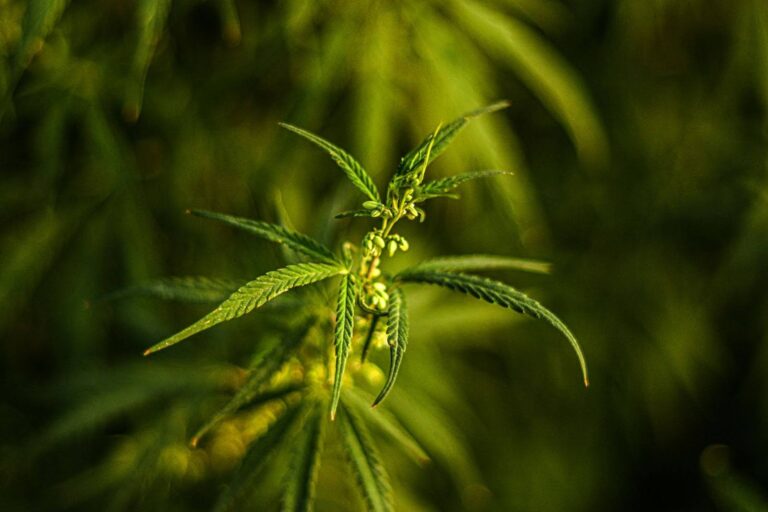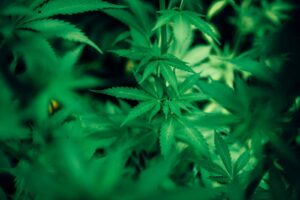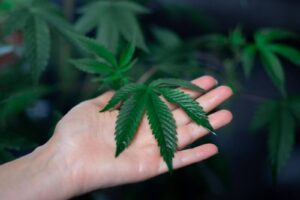Have you ever wondered why some cannabis plants grow bushy while others stretch tall and lanky? The answer lies in understanding plant structure, especially the role of nodes and internodes. These key elements determine how a plant develops, how efficiently it absorbs light, and even how resilient it is to environmental stress.
Nodes are the points where branches, leaves, and buds emerge, while internodes are the spaces between them. Their development affects everything from plant shape to flowering patterns. By understanding how they work, you can improve growth, maximize yield, and make informed training and pruning decisions.
This article explores the anatomy of nodes and internodes, their role in cannabis cultivation, and how to use this knowledge to enhance plant health. You will learn how to count nodes, recognize plant sex through node identification, and apply techniques that influence growth.
Understanding Cannabis Plant Anatomy
To grow healthy, high-yielding cannabis, you need to understand its anatomy. Knowing how your plant develops helps you identify growth stages, optimize care, and catch potential issues early.
Why Plant Anatomy Matters
Every part of the cannabis plant plays a role in its growth, health, and productivity. You can fine-tune your care routine and maximize yields by understanding the plant’s structure—from roots to flowers. Here’s why plant anatomy knowledge is essential:
- Optimized Watering and Nutrient Uptake: The root system absorbs water and nutrients. Knowing how roots develop and function helps prevent overwatering, root rot, and nutrient deficiencies.
- Effective Pruning and Training: Leaves, branches, and nodes dictate how your plant grows. You can trim unnecessary foliage, shape the canopy, and use training techniques like topping or LST (low-stress training) to encourage better bud production by identifying key growth points.
- Recognizing Growth Stages: Each part of the cannabis plant changes as it matures. Understanding how the stem thickens, how leaves form, and how bud sites develop allows you to adjust light cycles, nutrients, and environmental factors for each growth phase—seedling, vegetative, and flowering.
- Early Problem Detection: Leaves and stems often signal plant health issues. Yellowing leaves, curling tips, or weak stems can indicate stress, nutrient imbalances, or pest infestations.
Tracking Growth Through Nodes and Internodes
As your cannabis plant grows, you’ll notice sections where branches and leaves emerge from the main stem. These are nodes. The spaces between them are internodes. Both play a crucial role in understanding the plant’s development and health.
Identifying Growth and Maturity
Nodes are key indicators of how your plant is progressing. In the early stages, they help you determine whether the plant is male or female. As growth continues, nodes also mark where new branches and bud sites will form, giving you a clear view of how your plant is developing.
Monitoring Flowering and Stretching
During the flowering stage, nodes become even more important as this is where buds begin to form. Tracking their development helps you gauge when the plant is entering full bloom.
Internode spacing is also a valuable indicator. Short gaps between nodes mean the plant is compact and bushy, often a sign of good light exposure and controlled growth. Longer gaps may indicate excessive stretching, which can happen when the plant reaches for light due to poor positioning or inadequate intensity.
So, what are nodes on a cannabis plant? Let us understand in detail below.
What Are Nodes on a Cannabis Plant?
Nodes are the junctions on the stem where new growth emerges. They serve as the foundation of the plant’s structure and influence overall development, including branching, leaf formation, and bud sites.
Key Functions of Nodes:
- Branch and Leaf Growth: Nodes are the points from which new branches and leaves sprout, affecting the plant’s overall shape and ability to capture light.
- Bud Formation: Flowering nodes are where cannabis buds develop, making them critical for harvest yield and potency.
- Sex Identification: Nodes help determine whether a plant is male or female. Male plants produce pollen sacs at the nodes, while females grow pistils that develop into buds. Recognizing these differences early allows for proper plant management, especially if cultivating for flower production.
- Training and Pruning: Nodes are key locations for plant training techniques like topping, low-stress training (LST), and super cropping, which encourage bushier growth, better light penetration, and higher yields.
- Cloning Viability: Healthy nodes are essential for successful cloning. Taking cuttings from strong node sites ensures that new plants develop strong root systems and maintain genetic consistency.
- Nutrient Transport: Nodes act as distribution points where nutrients and water move to different parts of the plant, directly influencing growth rate and overall health.
Now, let us understand what internodes on a cannabis plant are.
What Are Internodes on a Cannabis Plant?
Internodes are the spaces between two nodes. These gaps are vital in determining the plant’s overall structure and development. Plants with short internodes tend to be compact and bushy, which is ideal for maximizing light absorption and airflow. In contrast, plants with long internodes grow taller and may require additional support to prevent weak stems and breakage.
Key Functions of Internodes:
- Plant Structure: Internodes define the plant’s shape and height, affecting how it grows in various environments.
- Nutrient and Water Transport: These segments act as channels for distributing essential nutrients and water between nodes, supporting overall plant health.
- Light Exposure Optimization: The spacing of internodes determines how effectively a plant captures light, influencing photosynthesis efficiency.
- Stress Response Indicator: Abnormal internode spacing can signal issues like excessive nitrogen levels, high temperatures, or inadequate light exposure.
- Growth Rate Regulation: Internodes reflect a plant’s genetic traits and environmental adaptations, allowing growers to assess and adjust cultivation strategies.
- Support for Bud Development: Well-spaced internodes provide structural integrity, ensuring that heavy buds do not cause branches to break.
- Adaptation to Environmental Conditions: Plants adjust internode spacing in response to humidity and airflow, which can influence overall plant health. PlanaCan helps you streamline scheduling with templates so you can automate tasks from planting to harvest. With a few clicks, you can schedule tasks, ensuring consistency and healthier plants.
So, what are the methods that you can use to count the nodes of your cannabis plant? Let us find out in detail.
Methods of Counting Cannabis Nodes
Counting nodes is a crucial technique for understanding your cannabis plant’s growth, guiding training methods, and determining the right time for various interventions like topping, pruning, or flowering. A node is the point where branches and leaves emerge from the main stem. Knowing how to count them properly helps you optimize plant health and yield.
Here are the most effective ways to count cannabis nodes:
1. The Standard Method
The most common way to count nodes is by starting at the bottom of the plant, just above the cotyledon leaves (the small, round leaves that first appear after germination). The first true set of leaves marks the first node, and each new pair of leaves that grows above it represents a new node. This method gives you a straightforward way to track your plant’s vegetative growth and determine when it is ready for different stages of care.
2. The Fimming and Topping Method
If you plan to top (cutting off the top growth to encourage bushier growth) or FIM (trimming part of the new growth to create multiple colas), counting nodes is essential. Typically, you’ll want to wait until the plant has at least four to five nodes before performing these high-stress training (HST) techniques.
Cutting too early can stunt growth, while waiting too long might lead to excessive stretching. A properly timed cut helps the plant recover faster and direct energy toward lateral growth.
3. The Internode Count Method
Instead of focusing solely on the number of nodes, you can also observe the internodes—the spaces between each node. These gaps provide insight into plant health:
- Short internodes suggest compact, bushy growth, often due to strong light exposure or indica genetics.
- Long internodes may indicate stretching resulting from low light intensity or sativa-dominant strains.
Tracking internode spacing helps you adjust light placement, nutrient levels, and environmental conditions to maintain optimal plant structure. PlanaCan makes it easy to track these adjustments by generating detailed reports for each harvest, capturing data on cultivation decisions and their impact on yield. With all information in one place, you can analyze trends, refine your methods, and improve profitability by identifying what works and avoiding past mistakes.
4. The Pre-Flowering Method
If you’re growing from regular seeds (not feminized), counting nodes is one way to determine plant sex before switching to the flowering stage. Pre-flowers begin forming at the base of branches around the fifth or sixth node, allowing you to distinguish male and female plants. Identifying and removing male plants early helps prevent accidental pollination, ensuring your female plants focus on producing buds rather than seeds.
5. The Alternate Node Method
In the early vegetative stage, nodes grow in pairs—each new set of leaves appears directly opposite the previous one. However, as the plant matures, nodes begin alternating along the stem instead of growing symmetrically.
This shift clearly signals that the plant has reached maturity and is ready for flowering. If you’re growing photoperiod plants, waiting for alternating nodes before switching to a 12/12 light cycle can lead to a more stable transition into the flowering stage.
6. The Growth Stage Reference
Nodes can serve as a rough guide to your plant’s developmental stage:
- Seedling Stage (1-3 nodes): Plants are fragile and should be handled with care. No training or topping should be done at this stage.
- Vegetative Stage (4+ nodes): The plant is actively growing and can handle training techniques like topping, low-stress training (LST), and defoliation. Most growers wait until at least 5-6 nodes before topping.
- Pre-Flowering (6+ nodes): The plant starts showing pre-flowers, which help determine sex.
- Flowering Stage: New node growth slows as the plant directs its energy into producing buds.
7. The Canopy Management Approach
If you’re using training methods like low-stress training (LST), ScrOG (Screen of Green), or mainlining, counting nodes is key to achieving an even canopy. The goal is to ensure that all tops receive equal light exposure, leading to uniform bud development. By tracking node growth, you can time your training adjustments to encourage bushier, more productive plants rather than a tall, uneven structure.
PlanaCan streamlines this by generating reports on cultivation decisions and yield impact. With all data in one place, you can analyze trends, refine methods, and avoid past mistakes, leading to higher yields and better profitability.
8. Counting Nodes for Cloning
If you plan to take clones, the best cuttings come from branches with at least 3-4 nodes. These branches have enough growth points to root successfully and develop into healthy plants. Taking clones too early (from weak branches with only 1-2 nodes) reduces the chances of survival, while waiting too long may lead to woody stems that are harder to root.
Now, let us discuss the factors that affect the development of cannabis nodes and internodes.
Factors Affecting Your Cannabis Plant’s Node and Internode Development
Your cannabis plant’s node and internode spacing influence its structure, airflow, and overall yield. Controlling these factors can help you shape plant growth for better results.
- Genetics: Sativa strains naturally have longer internodes and grow taller, while Indicas stay compact with shorter spacing. Hybrids fall somewhere in between.
- Light Intensity & Spectrum: Low light or too much red spectrum can cause stretching. Stronger, blue-leaning light encourages compact growth and tighter node spacing.
- Temperature & Humidity: Higher temperatures (above 85°F/29°C) cause plants to stretch, while cooler conditions keep them more compact. Proper humidity levels also prevent stress that can affect growth.
- Nutrients & Growth Regulators: Excess nitrogen leads to elongated internodes, while a well-balanced NPK ratio supports strong, controlled development. Some growers use plant growth regulators (PGRs) to manage node spacing.
- Airflow & Stress Training: Good airflow strengthens stems and prevents stretching. Training techniques like topping, low-stress training (LST), and supercropping promote bushier plants with more bud sites.
- Root Health & Container Size: Healthy roots mean balanced growth. Small containers can cause root binding, leading to stunted plants or irregular internode spacing. Ensure proper aeration and space for root expansion.
- Plant Spacing: Overcrowded plants compete for light, causing them to stretch. Proper spacing allows for even light distribution and better airflow, reducing unnecessary elongation.
- CO₂ Levels: Supplementing CO₂ (1,200-1,500 ppm) in a high-light environment boosts photosynthesis, promoting stronger, more compact growth.
- Watering Practices: Overwatering can suffocate roots, leading to weak growth, while inconsistent watering stresses the plant, affecting internode spacing. Keeping a stable watering schedule ensures steady development.
PlanaCan helps by providing a clear visual timeline for planning and tracking tasks, allowing you to schedule work months ahead while managing daily activities. With an adjustable calendar and centralized information, you can stay on top of dynamic needs, ensuring no task is overlooked. - Photoperiod & Light Cycle: The length of light exposure impacts internode growth. During vegetative growth (18/6 light cycle), plants develop spacing naturally, while switching to 12/12 in flowering influences the final stretch and bud development.
Now, let us understand how you can apply all this knowledge to ensure proper growth and handling of your cannabis nodes and internodes.
Applying Your Knowledge of Cannabis Nodes and Internodes
Understanding nodes and internodes is essential for maximizing cannabis yield and plant health. These structures influence how plants grow, how efficiently they use light, and even how resilient they are to stress. Here’s how you can use this knowledge to improve your growth:
- Control Stretching: Long internodes often mean your plant is stretching due to inadequate light. Keeping your grow lights at the right distance encourages bushier growth and prevents weak stems.
- Identify Plant Sex Early: Pre-flowers appear at the nodes, helping you determine whether a plant is male or female before full flowering. Removing males early prevents unwanted pollination.
- Prune and Train for Better Growth: Techniques like topping, FIMing, and LST (Low-Stress Training) focus on node manipulation to shape the plant, improve airflow, and maximize light exposure.
- Optimize Yield: More nodes mean more bud sites. Methods like SCROG (Screen of Green) encourage horizontal growth, ensuring maximum light penetration and increasing yield.
- Monitor Plant Stress: Internode spacing provides clues about plant health. Tight nodes may indicate excessive light, cold temperatures, or overfeeding, while long internodes can suggest heat stress or light deficiencies. Adjust your growing conditions accordingly. PlanaCan tracks these factors with detailed harvest reports, capturing cultivation data in one place. Analyzing trends helps you refine methods, avoid mistakes, and optimize yields for better profitability.
- Enhance Airflow and Prevent Mold: Dense node growth can create humidity pockets, increasing the risk of mold. Pruning lower nodes helps improve airflow and reduces disease risks, especially in humid environments.
- Choose the Right Strain for Your Space: Strain genetics influence internode spacing. Indicas tend to be short and bushy with tight nodes, while sativas stretch with longer internodes. Knowing this helps you select the right strain for your grow setup.
- Fine-Tune Nutrients and Watering: Internode spacing can indicate nutrient imbalances. Excessive nitrogen can cause stretching, while deficiencies may lead to stunted growth. Observing node patterns helps you adjust feeding for optimal plant development.
Conclusion
Nodes and internodes play a crucial role in cannabis cultivation. Learning how to identify, count, and manage these structures improves plant health and maximizes yield. Applying this knowledge lets you fine-tune your growing techniques and cultivate stronger, more productive cannabis plants.
Running a successful cannabis grow operation takes more than just understanding plant anatomy. You need efficient systems to manage tasks, track growth stages, and optimize yields. PlanaCan helps you streamline cultivation with automated work scheduling and an interactive calendar designed to simplify planning and tracking.
With customizable templates, you can automate each step of the growth cycle, ensuring consistency and efficiency. The visual timeline lets you plan months in advance while staying on top of daily tasks. By combining structured planning with real-time tracking, PlanaCan gives you complete control over your growing operation, making improving productivity and maximizing your harvest easier.
Schedule a free call today to learn how PlanaCan can improve your workflow and boost your yields.




